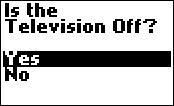|
...Continued from Page 2.
Since the screen only displays two colors, it exhibits an excellent contrast ratio and is visible under most lighting conditions, without use of the backlight. The LCD always remains on, even when the remote is inactive. The backlight can be disabled, or set to come on automatically with most hard button presses and turn off again after 5 or 10 seconds.
As might be expected for such a small clicker, the Harmony isn't exactly burdened by a multitude of buttons. Truth be told, there's quite a bit less than a lot: only 13 on the face, two of which aren't used for device control. Of note is a 3-way scroll wheel complemented by a [MODE] button on the right edge. This unique control is used exclusively for system-level remote operation and has excellent placement for use in either hand, with a finger or thumb falling naturally on top.

The "Help" button assists with resynchronizing a system.
|
Hard buttons on the remote include power, mute, volume, channel, plus a split-purpose transport and menu control cluster. At the bottom right is a "Help" button that provides context-sensitive assistance (in other words, it resynchronizes your system if it's out of whack). Although the LCD screen is backlit by six tiny LEDs, none of the hard buttons or their labels can be seen in the dark, a strange omission for a remote at this price point. The lack of backlighting isn't a deal breaker, as there are so few hard buttons that it's not difficult to memorize which is where. Tactile feedback proved to be adequate, but the oversized triangular volume and channel rockers tended to look better than they felt.
Everything but scissors.
Much like a Swiss Army Knife, the tiny Harmony sports a surprising array of stuff. In addition to the unique scroll wheel, you also get a small infrared sensor on the bottom edge and dual infrared emitters protruding out the front. One emitter is curiously angled downwards - it simply looks wrong at first - but the manual clarifies that this is as it should be. In theory, the angle should improve signal range when the remote is held. But our internationally ignored Menacing Thick Fluffy Blanket (MTFB) test showed otherwise, with the Harmony garnering a rather humble score of 2.0 regardless of what angle it was held. A red LED at the top of the remote's face lights up when commands are being transmitted.
Jammed between the IR emitters is a standard USB type "B" connector; computers with only old-fashioned serial ports are not supported. Using a standard port and cable type is thoughtful of Easy Zapper, but the remote's connector seems gargantuan compared to the size of the product itself. It's also quite exposed to possible damage and turned out to be a little sharp on the hand if the remote is picked up the wrong way around. Still, the placement is ideal when aligning two remotes to learn as the cable remains out of the way. A safer port placement would have been somewhere in the battery compartment, though the uncovered connector makes frequent programming updates to the Harmony quick. I also would have liked to see the infrared emitters concealed beneath a protective (and decorative) plastic shield, like most remotes use.
On the back of the remote is the obligatory battery compartment, concealing a trio of AAA batteries. Easy Zapper thoughtfully includes deluxe Panasonics in the package, so you won't be scrambling to power your new purchase. Batteries are rated to last for approximately two months; no recharging option is available. Anyone on the "rattle patrol" will note that the battery lid isn't completely secure and would benefit from a small piece of cushioning foam.
| 
